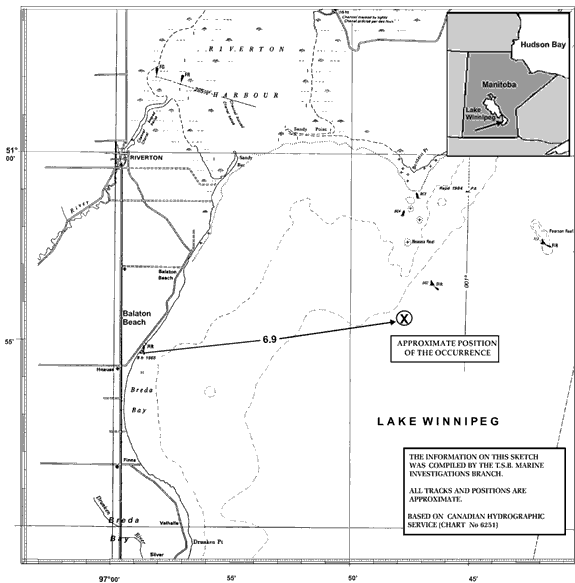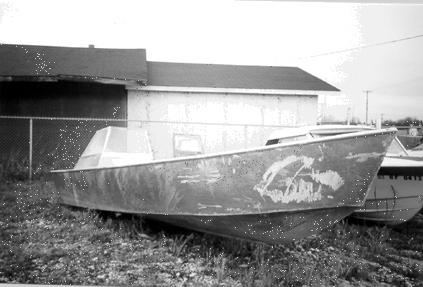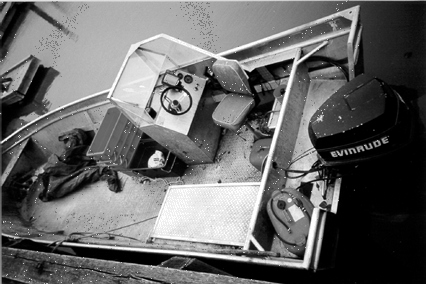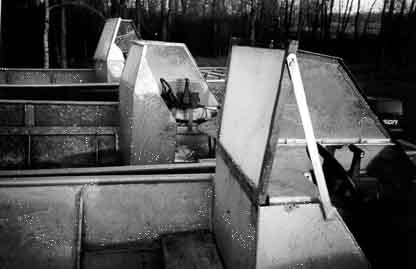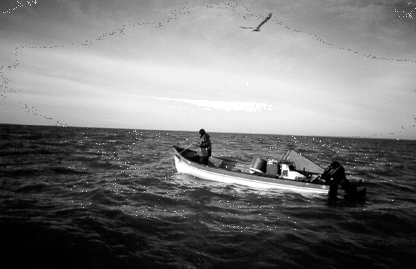Swamping and linking with loss of life
unnamed open-skiff commercial fishing vessel
off Hnausa Harbour, Manitoba
The Transportation Safety Board of Canada (TSB) investigated this occurrence for the purpose of advancing transportation safety. It is not the function of the Board to assign fault or determine civil or criminal liability. This report is not created for use in the context of legal, disciplinary or other proceedings. See Ownership and use of content. Masculine pronouns and position titles may be used to signify all genders to comply with the Canadian Transportation Accident Investigation and Safety Board Act (S.C. 1989, c. 3).
Summary
At about 1815 central daylight time, while gill netting in increasing wind conditions, an open commercial fishing vessel was swamped by a large cresting wave. The vessel lost its reserve buoyancy and quickly sank by the stern. Neither of the two men aboard was wearing a lifejacket or personal flotation device, nor were there any aboard. One person drowned.
Factual information
| Name | "No Name (Yawl)" |
|---|---|
| Registry/Licence number | (unregistered/unlicensed) |
| Port of registry | None |
| Nationality | Canada |
| Type | Lake Winnipeg Yawl |
| Gross tonnageFootnote 1 | approximately 1.5 |
| Length | 6.7 m |
| Draught | Forward: 8 cm Aft: 16 cm |
| Built | (approximately) 1982 |
| Propulsion | 100 horsepower Mercury Outboard gas engine (157 kg) |
| Crew Members | 2 |
| Passengers | nil |
| Owner | Brad Benson, Winnipeg Beach, Manitoba |
Description of the vessel
The vessel was constructed from a plan approved by Transport Canada (TC) and used by several area manufacturers. The manufacturer of the aluminum constructed occurrence vessel, Gimli Boat Works, of Gimli, Manitoba,Footnote 2 estimated that 300 to 400 vessels of similar design were built by their facility. The vessel incorporated a hard chine and a rise of the side plating with a pronounced flare toward the bow. There was a breast plate at the bow with an 0.2 m vertical pipe, termed the "horn", projecting from it. When fishing, the gill net is passed around the horn, the fish are picked out of it, and the net let back into the water.
A split steering control console was located about 2.5 m from the stern. At the deep well aft, near the motor, was an extended spindle with a handle, which was broken, connected to a gate valve below, at deck level. At the valve there was a second handle to close and open the valve. While the vessel is underway the gate valve may be opened to drain the vessel. When the vessel is not making way through the water, water will flood the hull if the valve is open. On 23 October 1999,the valve was initially reported as closed from the morning until the time of the occurrence. However, subsequent information indicated that it had been opened while travelling between gangs of nets.
The occurrence vessel did not carry navigation lights. The Collision Regulations require that vessels of this size and type, when operating at night (sunset to sunrise) or in restricted visibility, shall be so fitted. She did not carry navigation equipment nor any type of radio communication equipment nor was it required. There was no emergency position-indicating radio beacon on board nor is there a regulatory requirement for the carriage of one on this type of vessel.
The occurrence vessel was of an earlier Lake Winnipeg Yawl hull design, and was not fitted or retrofitted with optional flotation tanks or the increased freeboard scantlings now available. Industry development of this hull design now promotes two additional modifications to reduce the shipping of water. The inboard coaming around the deep well at the transom has been raised, and the hull sheer at the forward end was increased from midships for the same purpose.
History of the voyage
Three Lake Winnipeg Yawl vessels set out from Hnausa Harbour, Manitoba, on 23 October 1999, at approximately 0645.Footnote 3 They proceeded to a fishing area some 6.9 miles east-northeast of the harbour, where they began fishing with gill nets for pickerel, sauger and goldeye. In the early afternoon, one of the fishing vessels returned to Hnausa Harbour.
The occurrence vessel was crewed by two unlicensed fishermen. The operator had limited experience and his helper was a young novice. The owner of both vessels is a licensed fisherman. He and his assistant were aboard the accompanying vessel. Prior to departure, the owner had obtained a weather forecast for that day from a weather network telephone number provided by Environment Canada in Winnipeg.
Fishing was uneventful until late in the afternoon, when the wave height increased with the wind speed, which was averaging over 20 knots at this time. At 1800 the waves were averaging 1.3 to 1.6 m in height. Occasionally, larger cresting waves were encountered, but these did not deter the men from fishing or cause them serious concern for their safety. The fish crates stacked in the bottom of the boat made it difficult to see how much water had accumulated aft.
Working at the bow, the fishermen pulled in the net around the horn with each downward movement of the vessel's bow. The weight of the net limited the ability of the bow to rise with each approaching wave. At approximately 1809, as the rate of water ingress increased, fishing was still being performed. At about 1815 a large cresting wave came over the bow and in conjunction with water spilling over the stern quarters when the vessel dipped between the waves, the actions filled the vessel almost to the gunwales aft. At this time the vessel had a half load of fish, some 12 to 14 crates, but the operator was reluctant to throw any overboard to lighten the vessel.
Cautioning the helper to remain forward, the operator proceeded over the fish crates towards the stern with the intent of bailing water. After some 30 seconds, the operator asked the helper to pull the fish crates forward, but he could not do so. Another cresting wave came over the vessel's bow. As the vessel's stern quickly submerged, the bow tipped upwards, and the vessel sank stern first in approximate position latitude 51° 55′ N, longitude 96° 48′ W. The two fishermen were pitched into the water, which was six degrees Celsius. Each man clung to a partially filled five-gallon gas container.
The owner and his assistant were in the other boat, some 250 to 300 m upwind, and did not hear the cries for help of the two men in the water.
The operator was wearing a T-shirt and several sweat shirts underneath his oilskins. The helper was similarly dressed. Successive wave crests submerged them both and each time the little buoyancy remaining in the gas cans brought them slowly to the surface, just long enough to enable them to catch a breath. The helper, although a good swimmer, disappeared after 5 minutes. The operator's hand locked onto the handle of the gas can and all his muscles stiffened up.
Some 15 minutes later, in the accompanying vessel, it was realized that the occurrence vessel was not in view. The accompanying vessel proceeded to the site where the occurrence vessel had last been seen. The occurrence vessel operator was found in the water. He was suffering from hypothermia. With great difficulty he was pulled into the boat and was rushed ashore, at which point he lost consciousness.
On board there was no means of radio communication with which to alert the emergency services ahead of the vessel's arrival at Hnausa. On arrival, the Canadian Coast Guard (CCG) was notified of the occurrence and the hypothermic man was driven to the hospital in Gimli for medical attention.
Vessel Life-saving Equipment
The owner of the vessel believed that the life-saving equipment needed for his boat was a bailer, a knife and an anchor. This belief was shared by some of the seasonal fishermen with similar boats who were interviewed. They also were unaware of the minimum regulatory requirements for life-saving equipment or the risk to which they were exposed by the non-carriage of adequate life-saving equipment. Under the Small Fishing Vessel Inspection Regulations, these vessels are required to carry, inter alia, one approved lifejacket for every person aboard; one approved lifebuoy with 27 m of line; one watertight can containing six approved self-igniting flares; and one fire bucket.
Many of the Lake Winnipeg Yawl design of fishing vessel observed during the investigation did not carry the mandatory life-saving and safety equipment.
The occurrence vessel did not carry the sound signalling equipment required by the Collision Regulations which call for a vessel of less than 12 m in length to be provided with the means of making an efficient sound signal. A sound signalling device could have been used to aid in indicating distress.
Search and rescue
Neither vessel was equipped with the means to communicate by radio (nor were they required to be) with the CCG Marine Search and Rescue Base at Gimli, Manitoba. A marine radio could have been used by either vessel to transmit a Mayday call, indicating a distress situation.
A smaller vessel, crewed by the Royal Canadian Mounted Police (RCMP), is stored on a trailer at the Gimli detachment and is available for various police duties. However, local RCMP staff do not receive formal training in search and rescue techniques, heavy weather boat handling or electronic instrument navigation, nor are they equipped for search and rescue which is a CCG responsibility.
Systematic searches by the CCG and the RCMP were conducted over the next few days for the body of the helper and the sunken vessel; however, they were not successful. The visibility for the divers was less than 0.3 m, and the presence of abandoned fish nets made diving very risky. The body was recovered on 13 July 2000. The water depth at the occurrence site is approximately 15 m.
Experience of Personnel
The operator had operated small power craft for many years prior to working in the fish trade. He had one and a half years of experience in gill net fishing. He anticipated owning a Manitoba fishing licence issued by the Manitoba Department of Natural Resources once he fulfilled the two season requirement as a helper. He had ample rest for several days while waiting for the weather to abate and had worked for about 11 hours at the time of the occurrence.
The 17-year-old novice fishing helper was very keen to learn fishing and took every opportunity to visit the harbours of lower Lake Winnipeg. This was his first fishing trip. Despite suffering from asthma, he was a very good, award-winning swimmer. He was well rested on departure and had worked for about 11 hours at the time of the occurrence.
Gill Netting
Each net is approximately 100 m long. The fish nets are set in rows of 6 to 8 on average, and termed a "gang". The fish retrieved, typically pickerel or goldeye, are placed into fish crates, which weigh approximately 37.3 to 48.5 kg when full. The crates are stacked three tiers high on a flat, at the bottom of the vessel. The crates are placed on the flat in such a way so as to interlock them from gunwale to gunwale, in an attempt to immobilize them in a seaway.
Gill netting is often conducted by a pair of vessels in sight of one another. This is termed the "buddy" system. Fishermen who use the "buddy" system check on each other at intervals appropriate for the existing conditions.
Weather and Sea Conditions
The 0300 forecast for 23 October 1999 called for overcast skies and light southeast winds, backing to northwest. The wind did not back to the northwest but remained south-southeasterly, increasing to 20 knots. The actual wind gust speeds experienced at the time of the occurrence were higher than this; gusting 25 to 30 knots. The south basin of Lake Winnipeg is relatively shallow in depth and waves will quickly increase in size, in direct proportion to the increase in wind speed. Wave height information, for the time of the occurrence, received by the TSB, indicated that wave heights varied between 2 m and 2.5 m, mixed with an occasional 3 m wave.
Regulatory Overview
TC administers the Canada Shipping Act and its regulations, including the Small Fishing Vessel Inspection Regulations (SFVIR). TC does not have a sufficient presence locally to make an impact on the fishing community, a part of which appears to be unaware of the regulatory requirement to carry life-saving and safety equipment.
Copies of these regulations are not readily available locally, although fishermen may obtain them by contacting the TC office in Winnipeg or by visiting TC's web site.
The Small Fishing Vessel Inspection Regulations require vessels under 12.2 m in length and of under 15 gross tons which are engaged in commercial fishing to carry certain life-saving and firefighting equipment, based on the size of the vessel concerned. These regulations cover most of those vessels engaged in commercial fishing in Lake Winnipeg. However, the part of the Canada Shipping Act which applies to small fishing vessels under 15 gross tons exempts such vessels from annual inspection.
In the past, the RCMP has not been called upon--nor does it have the trained staff locally--to take life-saving and safety equipment enforcement action with respect to the life-saving equipment of these small commercial fishing vessels. However, whenever the opportunity presents itself, the RCMP will encourage the small commercial fishing vessel operators/owners to carry the proper life-saving and safety equipment.
The Department of Natural Resources (DNR) of Manitoba has issued approximately 900 fishing licences, with set quotas for each. To fish these quotas, there are an estimated 2000 full- and part-time fishermen. DNR Manitoba enforcement officers do not have a mandate to check the life-saving and safety equipment aboard fishing vessels, while in the process of conducting fish quota inspections, but does have authority to conduct compliance checks on recreational craft, pursuant to the Small Vessel Regulations, in Manitoba Provincial Parks.
In April 1999 a meeting of the regional Canadian Marine Advisory Council was held in Winnipeg. The meeting was held to promote safety to targeted commercial marine interests in the area. While representatives from TC and the CCG attended, only one stakeholder did so.
Analysis
Life-saving Equipment and Survival
The vessel did not carry any of the life-saving equipment specified in the regulations.
When the operator and his helper were thrown into the water, they had no means other than the vessel's portable gas tanks to provide flotation. The operator was fortunate in that his gas tank provided enough buoyancy to keep him afloat, particularly as it was determined that he was experiencing the symptoms of hypothermia by the time he was rescued.
Had the operator or his helper had access to an approved lifejacket, not only would the lifejacket have provided sufficient flotation, the whistle attached to the lifejacket could have provided the means to attract the attention of the accompanying vessel. Similarly, a flare or the use of a portable radio could have been used to attract attention.
Buddy System
Fishermen who use the buddy system benefit when the intervals between checking on each other are appropriate for the existing conditions. It appears that buddy system response made in this instance was not made in sufficient time to assist the accompanying fishing vessel crew, before loss of life occurred. There were no procedures or guidelines to follow with respect to the buddy system, to look out for one another. Working in pairs, within sight of each other, has obvious safety benefits and the buddy system most likely has been successful in the past for preventing loss of life. If the operator and his helper had been fishing alone, it is most likely that the operator would also have succumbed to either hypothermia and/or drowning. It is also very likely that the buddy system creates an increased level of comfort.
Situational Awareness
Although, it was initially indicated that the seacock was closed, later information received indicated that it had been opened while the vessel was under way to allow the venturi effect to help drain the bilge water from the boat. It was not closed while retrieving the nets so the stern was gradually filling with water. With both crewmembers working forward, water aft could not be seen due to the fish crates and the motion of the vessel in the seas would not have made it obvious. Furthermore, the operator of the occurrence vessel apparently did not have sufficient skill-based knowledge to recognize the dangers inherent in continuing to harvest fish while shipping water. No action was taken to lighten the vessel by discharging the crates of fish as the vessel was losing its remaining reserve buoyancy.
Given the deteriorating weather conditions, and that the owner of the vessels (who was the only experienced person there) was on-scene, it would have been prudent of him to suspend fishing and order both vessels back to port. For about 15 to 20 minutes, the owner and his helper, who were in the other vessel and preoccupied with fishing, were unaware of the disappearance of the occurrence vessel. The outcome of this insufficient level of situational awareness was that the necessary safety precautions with regard to weather and fishing conditions were not taken.
Self-enforcement - Small Fishing Vessel Inspection Regulations
TC has not maintained a large enough presence to make an impact on the local fishing community, particularly with respect to promoting awareness of the requirement to carry life-saving and safety equipment. Given the level of the TC presence, the applicable regulations become essentially self-enforced. However, copies of the regulations are not readily available locally from TC or through local fishermen's organizations. In addition, there does not appear to be an adequate audit mechanism in place at TC to monitor compliance. The result is that many vessel owners are unaware of the minimum safety equipment requirements.
Regulations made pursuant to the Canada Shipping Act can be enforced by the RCMP, only after the Minister of Transport has invited the RCMP to do so. The Gimli detachment of the RCMP had not been formally approached by Transport Canada, Marine Safety to enforce the relevant sections affecting commercial fishing vessels.
Vessel Loading and Shipping of Water
The fishermen involved in this occurrence did not have the necessary knowledge or experience to conduct a safe operation and they continued to load the vessel, in deteriorating weather conditions, until it was swamped.
Loss of Buoyancy
Those working forward, at the horn, could not see how much water had accumulated at the stern due to the open seacock and shipped water, because fish crates obstructed the view aft. The water shipped over the bow from the second large wave ran aft and its weight caused the vessel to further trim by the stern, markedly reducing the remaining reserve buoyancy to the point where the vessel downflooded and quickly sank by the stern.
Findings
Findings as to causes and contributing factors
- The vessel had been taking water through the seacock which trimmed the boat by stern and was swamped by two large cresting waves and sank quickly by the stern.
- When both fishermen were working at the bow they could not see the amount of water accumulating aft, due to the positioning of fish crates between them and the stern.
- Neither fisherman was wearing a lifejacket, nor was there any other life-saving equipment aboard the vessel.
- The distressed fishermen in the water did not have a means, radio, mechanical or pyrotechnic, of calling for assistance and their cries for help were not heard on the accompanying vessel.
- The helper drowned because he was not wearing a lifejacket.
Findings as to risk
- Although there are several hundred small commercial fishing vessels operating on Lake Winnipeg, despite joint RCMP and CCG water safety patrols, there has been little or no enforcement of the life-saving equipment requirements of the Small Fishing Vessel Inspection Regulations in recent years.
- There is a general lack of safety consciousness amongst the local fishermen and vessel owners, and few if any have requested from TC either information, an inspection, or a safety equipment audit.
- Dissemination and/or availability of information, in the form of literature or pamphlets, with respect to the statutory life-saving equipment requirements, has been very limited in the Lake Winnipeg area. There are no safe loading criteria, or literature, available.
Other findings
- The operator survived by holding on to a partially filled gas tank.
Safety action
Action taken
Transport Canada
Transport Canada, Marine Safety, Prairie and Northern Region has been re-organized with a resultant increase in staffing levels. Because of the large area covered by the Region, and the relatively small number of inspectors, it was decided to amalgamate activities with respect to small fishing vessels (under 15 gross tons), and other small commercial vessels below the size requiring an annual inspection. Inspectors will visit communities where small commercial fishing vessels operate and apprise operators of the requirements of the regulations and information on safety. The Region will be better able to deliver the applicable monitoring and inspection programs, and will commence an integrated program, including a communication strategy, to get the message out to all persons involved in small commercial vessel operations in the Region.
Owner
The owner's boats are now reportedly equipped with safety equipment, including bilge pump, marine radio and inflatable flotation vests.
Province of Manitoba
The Fisheries Branch, Manitoba Conservation, is cooperating with Transport Canada, Marine Safety by providing access to information on their files such that TC is better able to access fishers in the area and also to attend and participate in fisheries meetings held by the Province. Other initiatives are also being contemplated to mitigate fishing vessel accidents.
This report concludes the Transportation Safety Board's investigation into this occurrence. Consequently, the Board authorized the release of this report on .
